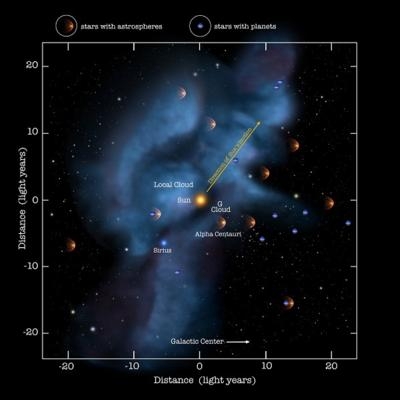Scientists Say Information Helps Us Know Our Place In The Galaxy
Like the wind adjusting course in the middle of a storm, scientists have discovered that the particles streaming into the solar system from interstellar space have most likely changed direction over the last 40 years. Such information can help us map out our place within the galaxy surrounding us, and help us understand our place in space.

The results, based on data spanning four decades from 11 different spacecraft, were published in Science on Sept. 5, 2013.
Vestiges of the interstellar wind flowing into what's called the heliosphere -- the vast bubble filled by the sun's own constant flow of particles, the solar wind – is one of the ways scientists can observe what lies just outside of our own home, in the galactic cloud through which the solar system travels. The heliosphere is situated near the inside edge of an interstellar cloud and the two move past each other at a velocity of 50,000 miles per hour. This motion creates a wind of neutral interstellar atoms blowing past Earth, of which helium is the easiest to measure.
"Because the sun is moving though this cloud, interstellar atoms penetrate into the solar system," said Priscilla Frisch, an astrophysicist at the University of Chicago, Ill. and the lead author on the paper. "The charged particles in the interstellar wind don't do a good job of reaching the inner solar system, but many of the atoms in the wind are neutral. These can penetrate close to Earth and can be measured."
Frisch became interested in this subject when results in January 2012 from NASA's Interstellar Boundary Explorer, or IBEX, showed that the interstellar wind was entering the heliosphere from a slightly different direction than had been observed by NASA's Ulysses mission in the 1990s. Frisch and her colleagues set out to gather as much evidence from as many sources as they could to determine whether the newer instruments simply provided more accurate results, or whether the wind direction itself changed over the years.
The earliest historical data on the interstellar wind comes from the 1970s from the U.S. Department of Defense's Space Test Program 72-1 and SOLRAD 11B, NASA's Mariner, and the Soviet Prognoz 6. While instruments have improved since the 1970s, comparing information from several sets of observations helped the researchers gain confidence in results from that early data. The team went on to look at another seven data sets including the Ulysses information from 1990 to 2001, and more recent data from IBEX, as well as four other NASA missions: the Solar Terrestrial Relations Observatory, or STEREO, the Advanced Composition Explorer, or ACE, the Extreme Ultraviolet Explorer, and the MErcury Surface, Space ENvironment, GEochemistry, and Ranging mission, or MESSENGER, currently in orbit around Mercury. The eleventh set of observations came from the Japanese Aerospace Exploration Agency's Nuzomi.

"The direction of the wind obtained from the most recent data does not agree with the direction obtained from the earlier measurements, suggesting that the wind itself has changed over time," said Eric Christian, the IBEX mission scientist at NASA’s Goddard Space Flight Center in Greenbelt, Md. "It's an intriguing result, which relied on looking at a suite of data measured in a bunch of different ways."
The various sets of observations relied on three different methods to measure the incoming interstellar wind. IBEX and Ulysses directly measure neutral helium atoms as they coursed through the inner solar system. IBEX's measurements are made close to Earth, while Ulysses' measurements reach out to the orbit of Jupiter.
The earliest measurements in the 1970s observed fluorescence that occurs when the extreme ultraviolet radiation coming from the sun scatters off the interstellar helium wind passing by the sun. Neutral helium atoms get caught by the sun's gravity, forming a focusing cone. As radiation from the sun bounces off these atoms, they give off light. Measuring the light provides information about the helium inflow direction.
The third technique to measure the helium wind relies on the fact that after this interaction with the sun's radiation, a fraction of neutral helium atoms gain an electron, and thus become charged. Many instruments in space are geared to study charged particles, such as instruments on NASA’s STEREO and ACE. Such instruments can measure the longitudinal direction of the particle wind, providing one last set of historical observations to round out the picture.
The data from these diverse sources shows that the direction of the interstellar wind has changed some 4 to 9 degrees over the last 40 years.
"Previously we thought the local interstellar medium was very constant, but these results show that it is highly dynamic, as is the heliosphere’s interaction with it," said David McComas, IBEX principal investigator at Southwest Research Institute in San Antonio, Texas.
While the reason for – and, indeed, the exact timing of – the shift is still unclear, Frisch pointed out that scientists know our solar system is close to the edge of the local interstellar cloud. Such an area of the galaxy might experience turbulence, and as we hurtle through space, the heliosphere could be exposed to different directions of wind. While the scientists don't yet know for sure how the direction switch happened, the team believes that additional observations should ultimately explain its cause, giving us even more information about the galaxy that surrounds us.
(Image provided by NASA)
 ANN's Daily Aero-Term (04.26.24): DETRESFA (Distress Phrase)
ANN's Daily Aero-Term (04.26.24): DETRESFA (Distress Phrase) ANN's Daily Aero-Linx (04.26.24)
ANN's Daily Aero-Linx (04.26.24) Airborne 04.22.24: Rotor X Worsens, Airport Fees 4 FNB?, USMC Drone Pilot
Airborne 04.22.24: Rotor X Worsens, Airport Fees 4 FNB?, USMC Drone Pilot Airborne 04.24.24: INTEGRAL E, Elixir USA, M700 RVSM
Airborne 04.24.24: INTEGRAL E, Elixir USA, M700 RVSM Airborne-NextGen 04.23.24: UAVOS UVH 170, magni650 Engine, World eVTOL Directory
Airborne-NextGen 04.23.24: UAVOS UVH 170, magni650 Engine, World eVTOL Directory




